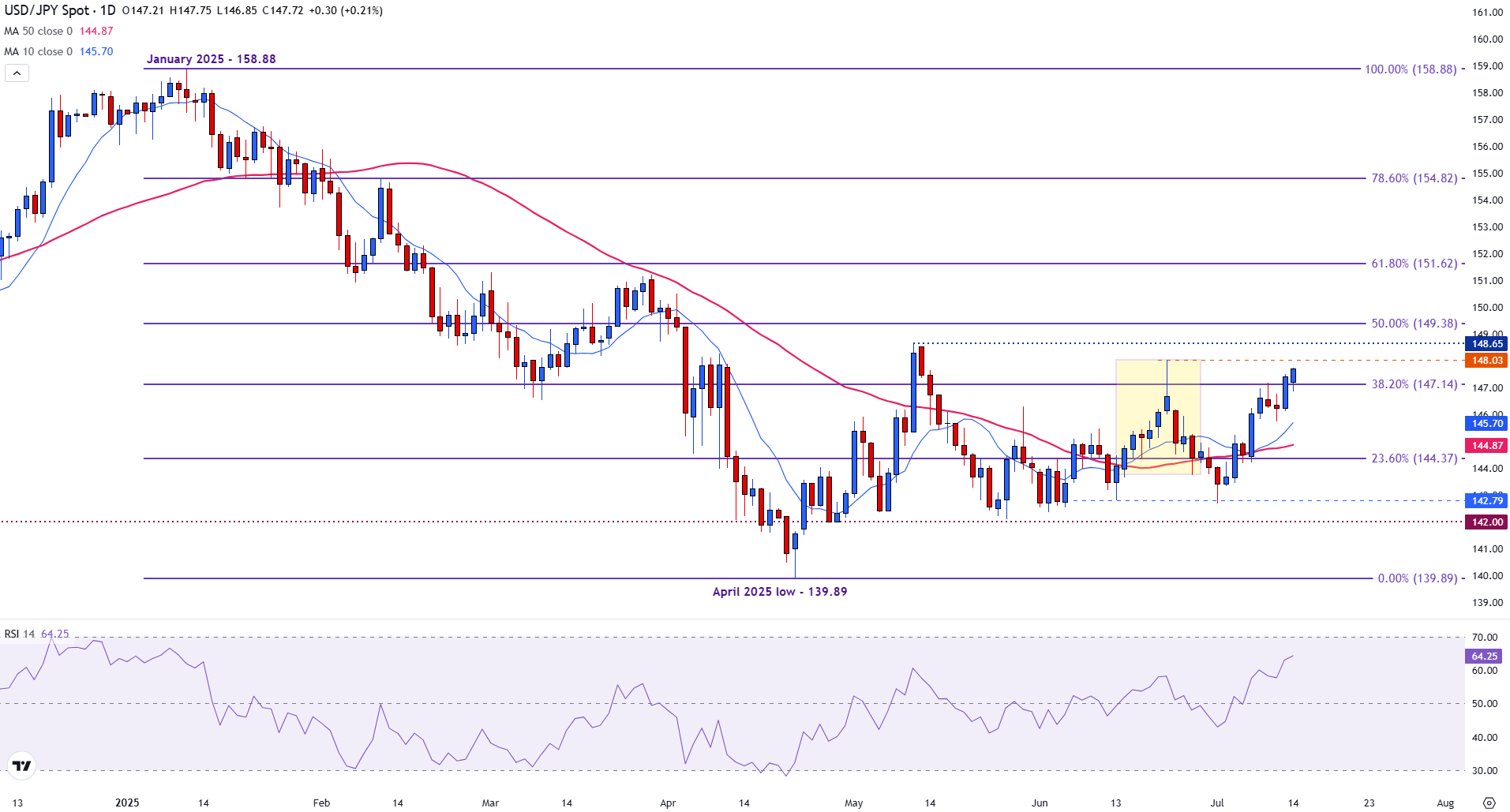USD/JPY climbs toward 148.00 ahead of US CPI data
- USD/JPY rises above 147.00 as investors look ahead to Tuesday's US Consumer Price Index release.
- The US Dollar remains bid against the safe-haven Japanese Yen as yield differentials remain supportive of USD/JPY strength.
- USD/JPY momentum turns bullish as the RSI rises to 64.
The Japanese Yen (JPY) remains on the back foot against the US Dollar (USD) on Monday as rate expectations and tariffs continue to drive sentiment.
With USD/JPY price action heading toward the 148.00 psychological level at the time of writing, attention is shifting to the release of US Consumer Price Index (CPI) data on Tuesday
For the Bank of Japan (BoJ), low interest rates of 0.5% have continued to drive funds into higher-yield currencies such as the US Dollar.
As the Federal Reserve (Fed) maintains rates within the current range of 4.25%-4.50%, yield differentials remain a prominent driver of the USD/JPY pair.
However, with US President Trump ramping up criticism against Fed Chair Jerome Powell, focus shifts to Tuesday’s Consumer Price Index data release.
Expectations are for CPI to show a monthly increase of 0.3% in June, with the annual rate expected to rise to 2.7%, from 2.4% in May.
Meanwhile, the core CPI figure, which excludes food and energy, is also expected to increase by 0.3% MoM, with the annual rate expected to increase to 3%, from 2.8% in May.
With the USD/JPY pair remaining vulnerable to shifts in rate expectations, Tuesday’s data remains crucial for the pair’s next move.
USD/JPY daily chart

From a technical standpoint, USD/JPY continues to edge higher, with support emerging at the 38.2% Fibonacci retracement level of the January-April decline at 147.14.
With price action lingering around 147.60 at the time of writing, psychological resistance remains firm at 148.00. A clear break of this level could see bulls retest the May high of 148.65, paving the way for the 50% Fibo level at 149.38.
In contrast, below the 38.2% Fibo level is the psychological support level of 146.00 and the 10-day Simple Moving Average (SMA) of 145.69. A break lower could see bears gain confidence, allowing them to retest the 50-day SMA support level at 144.87.
With the Relative Strength Index (RSI) reading near 64 at the time of writing, momentum is trading in favour of bulls, pushing the pair closer toward overbought territory.
US Dollar FAQs
The US Dollar (USD) is the official currency of the United States of America, and the ‘de facto’ currency of a significant number of other countries where it is found in circulation alongside local notes. It is the most heavily traded currency in the world, accounting for over 88% of all global foreign exchange turnover, or an average of $6.6 trillion in transactions per day, according to data from 2022. Following the second world war, the USD took over from the British Pound as the world’s reserve currency. For most of its history, the US Dollar was backed by Gold, until the Bretton Woods Agreement in 1971 when the Gold Standard went away.
The most important single factor impacting on the value of the US Dollar is monetary policy, which is shaped by the Federal Reserve (Fed). The Fed has two mandates: to achieve price stability (control inflation) and foster full employment. Its primary tool to achieve these two goals is by adjusting interest rates. When prices are rising too quickly and inflation is above the Fed’s 2% target, the Fed will raise rates, which helps the USD value. When inflation falls below 2% or the Unemployment Rate is too high, the Fed may lower interest rates, which weighs on the Greenback.
In extreme situations, the Federal Reserve can also print more Dollars and enact quantitative easing (QE). QE is the process by which the Fed substantially increases the flow of credit in a stuck financial system. It is a non-standard policy measure used when credit has dried up because banks will not lend to each other (out of the fear of counterparty default). It is a last resort when simply lowering interest rates is unlikely to achieve the necessary result. It was the Fed’s weapon of choice to combat the credit crunch that occurred during the Great Financial Crisis in 2008. It involves the Fed printing more Dollars and using them to buy US government bonds predominantly from financial institutions. QE usually leads to a weaker US Dollar.
Quantitative tightening (QT) is the reverse process whereby the Federal Reserve stops buying bonds from financial institutions and does not reinvest the principal from the bonds it holds maturing in new purchases. It is usually positive for the US Dollar.


